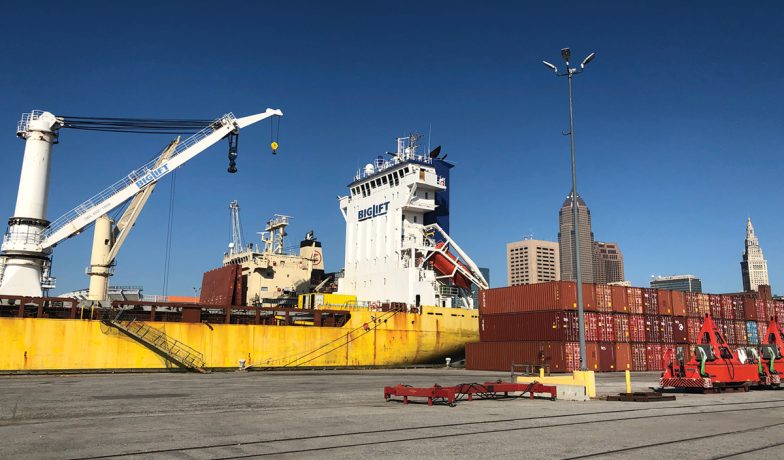ICCT Releases Report On Alt-Fuel Study
Benefits and Barriers
The International Council on Clean Transportation (ICCT) recently released the findings of a study focused on alternative fuels for the Great Lakes shipping industry. The U.S. Maritime Administration (MarAd) commissioned the “Feasibility Study of Future Energy Options for Great Lakes Shipping” in 2022. MarAd wanted a study “based on a practical approach toward supporting the Great Lakes shipping industry,” along with a report to serve as a reference for alternative-fuel work by technology developers and maritime companies.
The study was to provide an evaluation of benefits and barriers for:
- Synthetic natural gas, methanol, ammonia and hydrogen
- Biofuels such as ethanol, bio-methane, bio-ethane, bio-propane and bio-diesel
These are the power/energy options necessary for full-electric and hybrid propulsion and generation, such as shore power, solar photovoltaic, fuel cells and batteries.
Finally, the study was to present availability and an implementation timeline to 2050.
ICCT was selected to undertake the $350,000 study, which got underway in August 2022. The project included two partners: the American Bureau of Shipping (ABS) and the Great Lakes St. Lawrence Governors and Premiers (GSGP). ABS provided technical expertise on fuel characteristics. GSGP, with ABS and Michigan Technological University, developed a port survey on existing energy and fuel capabilities at key ports.
Making the Transition
GSGP highlighted some key findings and suggestions to start the shift to alternative–fuels.
Short-term (through 2030): Expand vessel electrification. Harbor craft and tugs are most suitable for direct electrification. Biofuel, depending on production, also holds potential for emissions reduction.
Medium-term (through 2040): Explore zero-emission fuels. Methanol, ammonia and liquid hydrogen hold potential.
Long-term (through 2050): Replace fossil fuels with zero-emission fuels where feasible. Because of diverse fuel options, regional collaboration will be key to support ports’ and terminals’ abilities to provide non-fossil fuels.
Regarding alternative fuels, the report suggests that:
All fuels analyzed have potential for Great Lakes-St. Lawrence Seaway shipping, including hybrid battery power for cargo ships. However, U.S. and Canadian policymakers will need to track technology trends and international policymaking before giving priority to one fuel or power option.
All alternative fuel pathways will be more expensive than fossil fuels for the foreseeable future; that price premium is expected to fall over time. To drive down costs, governments should consider implementing policies including incentives, carbon pricing and legally binding mandates.
In the short term (through 2030), ports and governments can explore expanding onshore power supply. Then, through 2040, methanol, ammonia and liquid hydrogen are potential fuels for shipping, but production capacity and bunkering infrastructure will need to expand to meet demand. In the longer term (through 2050), domestic and international climate targets will require the complete replacement of fossil fuels for shipping on the Great Lakes-St. Lawrence Seaway.
To track technological progress and to help decision-making, governments and ports, as is done in Europe, should collaborate to collect primary data on vessels for a new public fuel consumption and emissions database.
The report presents various policy recommendations and suggested tasks for port and government officials. To get to 2030, for example, the report suggests that ports and governments “explore expanding onshore power supply,” or “ports could provide biofuel infrastructure by converting typical MGO (marine gas oil) bunker tanks to biofuel tanks.”
Developing a Program of Work
John Schmidt, program manager at GSGP, said the organization is actively engaged in follow through and wants to make demonstrable progress in the short term. “In general, there is a high degree of interest from ports and some shippers to decarbonize,” he said.
He added that in the short-term, initial steps to reduce maritime emissions will depend on biofuels, electrification and data sharing to help optimize vessel routing.
Schmidt said of 12 ports contacted, 10 completed GSGP’s fuels/energy planning survey. Three (of six) survey questions asked port officials about:
- Fuel availability and storage capacities and who owned that infrastructure
- Natural gas infrastructure and capacities
- Electricity infrastructure, interconnections, total and excess capacities and electrical suppliers
- Plans or thoughts about shore power electrification or other alt-fuel projects
Schmidt said GSGP is selecting a consultant to help identify which Great Lakes-St. Lawrence Seaway ferries might convert to electric power relatively soon. This study should be complete by July. A similar tug and barge study is being planned. Additionally, discussions are ongoing now with shipping companies about the best approaches to expand shore power.
With biofuel, there is an effort in the United States and Canada to understand logistics, regulations and money. Schmidt said more information about this effort will be shared soon.
Regarding data sharing and smart shipping, Schmidt said GSGP is working on pilot projects for various technologies, such as underwater survey and precision dredging. Work is also continuing with GSGP’s partner port in Europe, the Port of Antwerp Bruges, regarding data sharing. Schmidt noted new digitalization work underway between the Port of Monroe in Michigan and Newlab could possibly expand to other Great Lakes ports.
Schmidt said GSGP’s FY25 work plan – under development now – will continue and expand on alt-fuel next steps, particularly to advance “the three buckets” of biofuels, electrification and smart shipping. “We’ve got a lot of good stuff coming down the pike,” Schmidt said, “and I’m very excited to have this report out there, and for our FY25 follow through.”
Emerging Opportunities
Joshua Padeti, senior engineer of sustainability at ABS, said there are a lot of opportunities in the world of shore power and biofuels, noting activites are underway within EPA’s Clean Ports Programs. He also mentioned IMO’s recent revision to allow marine fuel to contain up to 30 percent biofuel where previously the allowance was just 7 percent.
“Biofuel certification will become an important market, leading to the standardization of biofuels and thus become increasingly competitive as compared to other alternative fuel options,” he said. “Biofuel is a great transition fuel until zero-carbon fuels are fully developed and available.”
Padeti said ABS expects big increases in shore power, starting first in California and then slowly adopted in other U.S. ports. He noted that EPA’s new Clean Ports Programs will help fund and kick-start shore power investments.
Padeti said the ICCT study is a good source of information for ports and port officials as they seek to decarbonize. “The decarbonization market is heating up. We expect to see significant transformation within the decade with increased investments in this sector,” he added.
Ports on the Great Lakes have been made aware of the report. The Port of Cleveland was the first Great Lakes port to pass a Climate Action Plan, aiming to be carbon neutral by 2050. “The port is closely following various alternative energy initiatives that will affect the maritime industry,” said David Gutheil, chief commercial officer for the Port of Cleveland.
The Port of Cleveland was recently awarded a $34 million grant to modernize and electrify its largest warehouse. This project will install plug-in capabilities, part of a transition away from diesel equipment to electric power. Gutheil said design and planning on the project are starting now.
Great Lakes Ports Respond to ICCT Report
Port of Chicago: Interested in windfarms and hydrogen.
Port of Cleveland: Focusing on electrification and moving away from diesel-powered equipment.
Port of Detroit: Received a $1 million decarb planning grant; investigating shore power for cruise ships; seeking federal funds for solar panels and a “hydrokinetic energy harvester.” Hydrogen is being considered.
Port of Duluth-Superior: Provides shore power and is exploring cold temperature impacts. Conversion to electric vehicles is likely. Engaged in conversations surrounding hydrogen.
Erie Western Pennsylvania Port Authority: Officials want project validation before making alt-fuel investments.
Port Milwaukee: Planning and designing future infrastructure is underway.
Port of Montréal: Seeking a technologically neutral approach to decarbonization; provides shore power, working to transition to electric equipment; interested in LNG.
Port of Oswego: Exploring solar farms; considering renewable energy.
Port of Québec: Exploring alternative fuels, including electrification and hydrogen. LNG is already offered at ship docks. High-voltage shore power for cruise ships is a priority. All efforts need long-term transitional planning.
Port of Thunder Bay: Might convert a hydraulic crane to biofuel; looking into electrification of conveyor equipment.

Sea Lamprey Control Initiative Enters Five-year Implementation Phase
The Supplemental Sea Lamprey Control Initiative (SUPCON) has entered a new, five-year implementation phase following several years of successful proof-of-concept research. Funded by the Great Lakes Fishery Commission, SUPCON expands... Read More

Alliance for the Great Lakes Addresses the Impact of Data Centers
The Alliance for the Great Lakes (AGL), a nonpartisan, nonprofit organization that works to protect, conserve and restore the Great Lakes, is investigating the impact of data centers and agricultural... Read More



